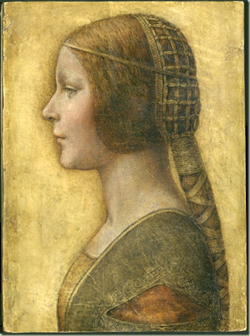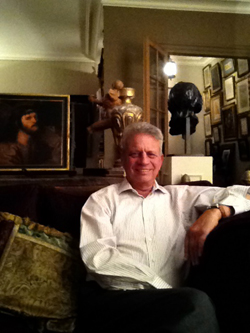I love trolling dank antique stores, steamy flea markets, random auctions, awkward estate sales and such. I love the whimsical mental charge I get from the thought that if I just stick it out long enough, I'll inevitably stumble upon some long-overlooked treasure which will make me richer, more interesting, and challenge or even change cultural history as we know it.
And, most likely, so do you.
Alas, despite years of such sleuthing, The Big Discovery continues to elude me, and based on the many hours I have logged watching Antiques Roadshow, it seems we're all pretty much in the same boat.
Recently, however, one intrepid fellow did hit the jackpot. I give you Peter Silverman and his incredible story, told in the new release Leonardo's Lost Princess: One Man's Quest to Authenticate an Unknown Portrait.

In 1988, whilst perusing the catalogue for Christie's annual Old Masters sale, Silverman placed a $17,000 bid on a small portrait of a young woman in profile listed as "German, early 19 century," struck by its beauty and mildly suspicious of the attribution. He was outbid that day--it sold for a total of just over $22,000--but was stunned and delighted to stumble upon it a few years later in a Manhattan gallery where he immediately scooped it up for $19,000.
Thus began the wild and utterly fascinating journey outlined in the book that led to re-attribution of the work as Leonardo's La Bella Principessa--with an estimated value of over $150 million.
Leonardo's Lost Princess is much more than just a tale of an amazing discovery. The narrative is peppered with great insights into Leonardo and his contemporaries. The portions devoted to the search for the identity of the subject (determined to be young Bianca Sforza, beloved illegitimate daughter of Duke Ludvico Sforza of Milan) and where exactly the work came from (a manuscript, La Sforziada, likely to have been prepared to commemorate her wedding) is in itself a mini history lesson of life in the Renaissance era.
In chronicling the extraordinary efforts to confirm the suspicions that Silverman had indeed uncovered "a $100 million mistake" (in that it was completely misattributed by leading experts at Christie's and elsewhere) we are given a close-up view of the modern process of art authentication where, as the author indicates, "science and scholarship must walk hand in hand." On that, curious insights abound into the "imperious and closed art world" in the book, most startlingly in the tales of the small but influential group of art establishment figures--mainly in New York where the oversight was made to begin with--who persist in denying the Leonardo attribution. Indeed, we learn that some of them have refused to even view La Bella Principessa, in spite of most of the world's leading Leonardo scholars--backed by carbon dating, digital examinations with multispectral imaging and even fingerprint analysis--fully supporting it.
Leonardo's Lost Princess is an extraordinary tale told beautifully. I've not been more excited by a read in ages, and I cannot recommend it highly enough.
Author's note: I was so taken with this story, I couldn't resist contacting the Paris-based Silverman to learn more. Excerpts of our conversation follow.
CJ: My first question is one I like to ask of all lovers of art. I vividly remember the moment when, as a disinterested child, I suddenly knew that art would be a major part of my life going forward. I was 11 years old or so and, having been dragged by my mom to either the Getty or the Norton Simon, I laid eyes on the Degas sculpture La Petite Danseuse de Quatorze Ans and that was it. Does your passion for art trace to a specific memory or was it the kind of thing that just developed gradually over time?
PS: My art consciousness began somewhat late, at the ago of sixteen, when I had begun taking a serious interest in the female species. The way to impress the precocious, Manhattan-born and bred sophisticated little ladies was, I soon discovered, to invite them for an afternoon to the Museum of Modern Art. And it was there I first encountered the luminous sensuality of Degas and Gaugin. They were my first loves and to this day I still hope to perhaps own a pastel or oil of either one of these, my first 'masters'.
CJ: I note that La Bella Principessa is not the first work you have found to have been misattributed. Talk briefly about the others and how the art establishment reacted to those particular discoveries
PS: I am currently writing a second book which I believe will reveal some rather amazing things and I prefer to keep it all a surprise until next year. I can assure you it may be every bit as explosive as the Leonardo revelation.
CJ: I imagine as the Christies'-dubbed "German, early 19th century" work that sold for $20,000 or so began to morph before your eyes into a 15th century masterpiece worth $150 million or so, you were presented with a host of new issues relating to security, insurance, and the like. I'm not asking you to divulge too much, obviously, but-- how does one go about owning a Leonardo? Can you, for example, even enjoy it in your home or is that just totally out of the question? I imagine just moving the thing between one place and another is a major logistical undertaking...
PS: It's unfortunate that we can now only enjoy a fine facsimile at our home. The work is kept in a climate-controlled secure location. There is nothing that would give my wife and myself more satisfaction than having the work on public view in a major museum where it can be enjoyed and studied. Unfortunately, curators shy away from controversy and no one has come forth to say 'We want to exhibit this beautiful princess for all the world to see and enjoy.' They have this absurd attitude that by showing it they will be putting the weight of their institutions into establishing its value. As a promised gift, however, I have been assured they would be delighted to show it!
CJ: Does the fact that La Bella Principessa appears to be an experiment of sorts--on Vellum, which he was previously never known to have used, the then-peculiar chalk-ink mix, etc-- make it even more important than, say, if it had been a more typical discovery? I mean, we all know Leonardo's surviving oeuvre is tiny to begin with, but what you have stumbled upon is a particularly special treasure, no?
PS: Leonardo, like all great geniuses, was restlessly inquisitive and innovative. He was constantly experimenting with new materials and ideas, striking out in new directions. There is nothing ever 'typical' in his work and approach to art. The highly complex technique of this work testifies to this. Using parchment in this particular manner was a challenge--extremely complex, and impossible for a lesser artist to duplicate, as convincingly demonstrated in the NOVA documentary, Mystery of a Masterpiece.
CJ: By the time this is published, Leonardo's Lost Princess will have been out for about two months. How has the feedback been?
PS: Rather positive, thank you. I was especially gratified to receive an e-mail from an art historian I greatly respect that ended "the book should be put on the reading list at the Education courses of Sotheby's and Christies as well as at the Courtauld Institute and the Institute of Fine Art, New York." Now that is a tall order.
CJ: Do you sense that any of the naysayers, mostly the 'New York Gang' as you dub them, may change their tune or even be willing to look at the work as a result of the NOVA documentary or the book?
PS: It is an unfortunate fact of life that people are quick to vilify, attack and criticize but notoriously shy about admitting they were wrong. Not a single detractor has yet come forth. The mantra of many scholars and curators is, unfortunately; to avoid a mess--say NO, not yes!
CJ: The reality of science working side-by-side with scholarship coming into rapid prominence is a harsh one for some, isn't it? It's not at all a stretch to suggest that in the very near future, we'll be seeing a lot more missed discoveries, not to mention, coming to realize that some very serious works currently hanging in major museums will be revealed as fakes...you can almost feel the establishment panicking, but should they? Technology is always coming along to disprove ages-held theories...why such fear in the art world of knowing truths?
PS: Old habits die hard. Many scholars still are suspicious of anything that will put their 'connoisseurship' in question, not fully comprehending that working WITH the advances technology now offers can be a serious advantage. Pascal Cotte and Jean Penicaut have invented a camera that can virtually clean a painting, without risk of physically damaging it. They have shown the Mona Lisa's true, original colors before centuries of dirt and varnish have obscured this seminal work. Yet incredibly, a leading Italian Leonardo scholar recently scowled at Pascal that he was opposed to his camera because it revealed things that "Leonardo had never intended to be seen!" One can only shrug one's shoulders at such medieval thinking and hope that this scholar will never need medical assistance using diagnostic techniques such as scanners, x rays and the like!
CJ: In the Epilogue, you suggest that the portrait was most probably cut from the book (La Sforziada) after Bianca's death for "no longer serving a political or sentimental purpose." Talk a bit about what you mean by that. Any theories--even wild ones-- on what became of it after it was cut?
PS: Credit for discovering the original book that once contained the Bella Principessa drawing must go to Professor D.R. Edward Wright after an initial intuition by Professor Martin Kemp. I will leave it to the scholars to theorize.
CJ: Say you were to call up Christie's tomorrow and tell them you wanted to sell the work. Or say you were to donate it to the Met. How do you think they would attribute it?
PS: They might say that it was painted by Peter Silverman.
CJ: Assuming the book went to print months ago, I wonder if there are any updates to the story? Any new information or developments?
PS: New, surprising and vital information about the La Sforziada manuscript will be forthcoming from Professor Wright and others. This will solidify--actually, cement--the attribution to Leonardo.
CJ: What's next for you and Kathy, and what's next for La Bella Principessa?
PS: Kathy and I will be out there doing what we enjoy best, besides traveling and gardening--treasure hunting. There is still so much to be uncovered and discovered. As for the work, I fervently hope a major museum will come forth to exhibit it--perhaps together with the Warsaw La Sforziada manuscript which once contained it.

